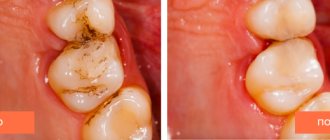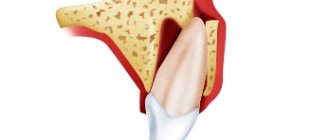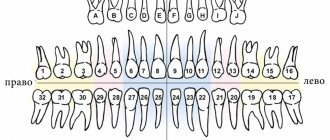What does it represent?
Apexification is a labor-intensive process. The duration of execution directly depends on the qualifications of the doctor and strict adherence to the sequence of actions.
Various medical technologies are used to close the root tip. The most effective method is considered to be the sequential replacement of artificially installed materials in the formed root canal. As a rule, materials containing calcium are used to carry it out.
There is another method by which apexification is carried out. It consists of using the Pro Ruth MTA material. It has full biocompatibility with natural tissues, which has been confirmed by many medical tests, and is therefore widely used in pediatric dentistry.
Materials [edit]
Various materials are used for apexification, such as mineral trioxide aggregate (MTA), bioceramics and biodentine.
Mineral trioxide aggregate[edit]
Mineral trioxide aggregate (MTA) consists primarily of tricalcium silicate, tricalcium aluminate, tricalcium oxide and silicate. It was used in endodontics as a root canal filling material and set in the presence of moisture. [5] It comes in either gray or white form, the difference between the two being that white MTA lacks iron. [6]
After numerous tests and analyses, MTA has shown excellent physical properties and biocompatibility. It has been shown to have less edge gap formation, less leakage and better adaptation than other fill materials. Additionally, root ends filled with MTA showed good healing with no periradicular inflammation over the root end filling material compared to amalgam. [5] The use of MTA as an endodontic restoration material stimulates bone formation and also inhibits bone resorption. [6]
Due to its physical properties and biocompatibility, MTA has been used in many clinical situations other than root-end filling. It is widely used for healing perforations, closing open apices during apexification, as a direct pulp capping material for a deep carious tooth, and for capping pulp stumps for apexogenesis. This material has excellent sealing ability, good antimicrobial activity, excellent biocompatibility and enhances dentin biomineralization. [5] However, there are some known disadvantages to using MTA, such as the potential release of hazardous substances, the possibility of discoloration, and inconvenient handling. [6]
Bioceramics [edit]
To overcome the limitations of MTA, recent advances in dental materials have introduced bioceramics as a new material for root canal obturation and restoration. Its composition mainly includes zirconium oxide, calcium silicates, monobasic calcium phosphate, calcium hydroxide, filler and thickeners. [6]
In a pre-mixed form, it is easy to use and is used in root canal treatment. Biodentine has the same properties as or better than MTA in terms of biocompatibility, antimicrobial activity, sealing ability and the ability to enhance dentin biomineralization. The bonding ability in high humidity environments and color stability of biodentine were significantly better than MTA. [6]
Biodentine [edit]
Biodentine is a tricalcium silicate-based material as an alternative to permanent dentin. It is biocompatible and is a new biologically active dentin cement replacement, which consists of a powder that consists of tricalcium silicate, dicalcium silicate, calcium carbonate, calcium oxide, zirconium oxide, and calcium hydroxide. It provides a good marginal seal, thus preventing marginal leakage and also protecting the underlying pulp by causing the formation of tertiary dentin. [7]
Unlike other dentin substitutes, the application of biodentine does not require conditioning of the dentin surface to ensure a good seal. This is due to the fact that mark-like structures are formed after the biodentin material penetrates the dentinal tubules. In addition, various adhesives can be applied to the composite resin before finishing it. [7]
Biodentine has a shorter setting time than MTA. In conclusion, this material is clinically indicated for permanent dentin replacement, direct and indirect pulp capping, pulpotomy, root furcation and perforation restoration, retrograde root end filling and apexification. . [7]
Clinical picture
Most dentists are unanimous in the opinion that therapeutic measures aimed at preserving the dental pulp are the treatment of developing immature teeth that are located on the pulp.
The apexogenesis technique allows the dentist to continue root formation and provide apical closure. Previously, two medications were used for the procedure. Despite the fact that the list of analogues has expanded, they are still used today.
- USP (calcium hydroxide). A popular remedy used for this therapeutic event. It allows you to preserve the vital activity of the pulp and is widely used in many dental clinics. To date, this drug is considered the most effective. It can be used to achieve maximum intensity during biocoating of the natural dental nerve.
- MTA (mineral trioxide). Some doctors consider this drug to be a real endodontic find, since it can be used in various clinical cases, and also has isolating properties.
Other drugs are also used in dental practice.
Apexification using mineral trioxide aggregate: a clinical case
Tags: Periodontitis of immature teeth
Abstract Mineral trioxide aggregate (MTA) has been proposed as an alternative to traditional materials used for root perforation closure, pulp capping, and retrograde root canal filling. It has excellent biocompatibility and ability to seal the root canal system. Traditionally, calcium hydroxide Ca(OH)2 has been used to apexify immature permanent teeth, but MTA represents a promising alternative to this material for a variety of indications. This article reviews the use of Ca(OH)2 as a traditional apexification material, providing an overview of the composition, properties and applications of MTA, with an emphasis on its use in root apexification of permanent teeth with incomplete apex formation. A clinical case is given as an example of such use.
Introduction Trauma causes cessation of root development, making it difficult to create an artificial barrier or promote closure of the apical foramen by calcified tissue. The first description of MTA in the literature appeared in 1993, and the use of this material in endodontics was approved by the US Food and Drug Administration in 1998. Until 2002, there was only one type of MTA material in the form of a gray powder, then white MTA. Both materials contain 75% Portland cement, 20% bismuth oxide and 5% gypsum by weight. The purpose of apexification is to form mineralized tissue at the apex and limit bacterial infection of an anterior tooth with an unclosed root apex. Disadvantages associated with the use of Ca(OH)2—the need for multiple dental visits to replace the material and the risk of reinfection due to leaking temporary fillings—have led to the use of MTA, which forms a barrier and prevents microleakage. MTA is biocompatible and promotes the formation of dentinal bridges and the regeneration of the periodontal ligament. It stimulates the production of cytokines in bone cells; this indicates that MTA actively promotes hard tissue formation.
Clinical case A 14-year-old female patient was referred to the Department of Pediatric Dentistry and Orthodontics at Al-Quds University in Jerusalem for examination and treatment due to pain in the area of the maxillary central incisors. In a conversation with the patient, we found out that 4 years ago she suffered an injury that caused damage to the enamel and dentin. She was not provided with dental care at that time. After about 2 years, a soft swelling appeared in the area of the apex of the roots of the central incisors, and sensitivity appeared when biting on the tooth. The patient had a drainage installed, providing access to the pulp chamber from the lingual side. Without any reason, the patient interrupted the treatment, then another dentist tried to achieve apexification with Ca(OH)2 paste for 6 months, but to no avail. After conducting an external and intraoral examination (including obtaining an x-ray), it was determined that the central incisors of the upper jaw were located normally and identified a crack in the thickness of the enamel and dentin. The root canals are wide, the roots are not fully formed and have open apexes, and lesions are observed in the periapical region (Fig. 1). A rubber dam was applied, and the root canal system was cleaned and shaped. For irrigation, a 2.5% sodium hypochlorite solution was used. The length of the root canal was determined using an apex locator and confirmed radiographically. For disinfection, Ca(OH)2 paste was injected into the canals for 1 week. On the second visit, Ca(OH)2 was removed from the canals using machine instruments, the canals were rinsed copiously with sterile water and dried using sterile paper points. MTA was mixed immediately before use, inserted into the canal using a special carrier, and compacted with a plugger to form a 3–4 mm long apical plug according to the manufacturer's instructions. An x-ray was taken to ensure that the material had not been pushed beyond the apex.
Rice. 1. X-ray examination showed damage to the pulp tissue and the presence of periapical lesions caused by tooth trauma.
This attempt to create an apical plug in the canal of the maxillary right central incisor was unsuccessful (Fig. 2).
Rice. 2. First attempt to place an apical MTA plug at the root of the maxillary right central incisor (tooth 11).
The MTA was removed from the canal using sterile water and the procedure was repeated (Fig. 3). Wet paper points were inserted into the canals, and the access cavities were closed with temporary fillings made of IRM material (DENTSPLY).
Rice. 3. MTA plug in the apical third of the canal.
After 2 days, the coronal and middle third of the canals were obturated using the vertical gutta-percha condensation method, and the final restorations were installed (Fig. 4).
Rice. 4. Traditional obturation with gutta-percha.
Clinical and radiological assessment of the healing progress was carried out after 6, 8 and 12 months (Fig. 5, 6). The use of MTA followed by conventional endodontic treatment allowed the formation of root apices of the central incisors (see Fig. 6).
Rice. 5. Control radiograph after 6 months.
Rice. 6. Control radiograph after 12 months.
Discussion Traditional apical Ca(OH)2 barriers have been associated with unpredictability of apical closure, prolonged barrier formation, poor patient discipline, risk of re-infection due to the difficulty of good sealing with temporary filling materials, and an increased likelihood of root fracture due to its low root density. thickness or prolonged contact of root dentin with Ca(OH)2. Because of this, the one-visit apexification method is becoming increasingly popular today. This procedure involves the conservative introduction of a biocompatible material into the apical third of the root canal. The goal is to form an apical barrier that allows immediate occlusion of the canal. Torneck et al. found that when the apex is clinically successfully closed with Ca(OH)2, histological examination shows incomplete formation of the dentinal bridge. In many cases, periapical inflammation persists because necrotic tissue is present in the caverns and recesses of the bridge. The main goal of biomechanical research is the restoration of lost bone. Absorbable tricalcium phosphate ceramics have been developed for this purpose. Koenigs, Brilliant and Driskell found that the use of this material causes closure of the apices of vital teeth in primates. They also observed regeneration of the periodontal ligament around the root apices, accompanied by minimal inflammatory response. Herbert has documented long-term success with the use of a tricalcium phosphate plug as an apical barrier, formed as part of a one-step apexification process. In other studies, teeth with open apices were successfully obturated after forming an apical barrier of dentin and Ca(OH)2 or dentin chips and hydroxyapatite. One-stage apexification using MTA as an osteoconductive apical barrier is gaining popularity. MTA is relatively noncytotoxic and stimulates cementum formation. By leaching calcium and hydroxyl ions, this material creates a highly alkaline aqueous environment, which is made biologically active by the formation of hydroxyapatite in the presence of phosphate-containing liquids. Unlike Ca(OH)2, prolonged contact of immature roots with MTA does not reduce their strength. According to Torabinejad, MTA contains tricalcium silicate, tricalcium aluminate, tricalcium oxide, silicate oxide and several other mineral oxides that are responsible for the chemical and physical properties of the material. The powder consists of small hydrophilic particles that polymerize in the presence of moisture. Wetting the powder results in the formation of a colloidal gel with a pH of 12.5, which polymerizes in approximately 3 hours. The compressive strength of MTA is equal to that of temporary restorative material and SuperEBA (Bosworth), but inferior to that of amalgam. It is sold under the name ProRoot MTA (DENTSPLY) and is recommended for immediate obturation of open apices. When used close to periradicular tissues, MTA demonstrates the ability to induce the formation of cementum-like hard tissue. Due to its excellent sealing properties, biocompatibility and ability to polymerize in the presence of blood, MTA is a promising material. Moisture entering the apex before barrier formation is often a problem with apexification using other materials. In the case of MTA, which is hydrophilic, the presence of moisture does not affect the quality of the apex seal. Shabahang et al. conducted a histomorphological comparison of hard tissue formation and inflammation after treatment of open apices with osteogenic protein-1, MTA and Ca(OH)2. MTA induced hard tissue formation most consistently, but differences between materials in terms of hard tissue volume and degree of inflammation were not statistically significant. MTA has demonstrated the ability to stimulate cell differentiation to form hard tissues and create the appropriate matrix. Several animal studies have shown that MTA provides more predictable results than Ca(OH)2. In a prospective patient study, 57 teeth with open apices were obturated with MTA in one visit. After 12 months, 43 teeth were available for examination, and the results were classified as successful in 81% of cases. Despite its good physical and biological characteristics, MTA has the disadvantage of a long polymerization time. Calcium chloride was used to stimulate curing of the material; According to studies, the addition of calcium chloride also improved the physicochemical properties of MTA and its sealing ability.
Conclusions Based on the results of this study, the following conclusions can be drawn: •Clinical and radiological evidence was obtained of the successful results of using MTA to promote apical closure of necrotic permanent teeth. •MTA is a suitable replacement for Ca(OH)2 in apexification.
Source: dental-tribune.com
Similar articles:
Ricucci Domenico, Jeen Nee Lui, Wen Yi Lim
Immunofluorescence study to evaluate the results of endotherapy. Results of treatment of chronic periodontitis of a premolar with an immature root
Cancellation
This study presents the results of immunofluorescence histological analysis of REPs in which adequate root canal disinfection was achieved.
Ricucci Domenico, Jeen Nee Lui, Wen Yi Lim Read
Umrana Faizuddin, Raji Viola Solomon
Clinical case of tooth revitalization using fibrin-enriched plasma
Cancellation
Root systems of teeth with exposed or incompletely formed apices cannot be adequately cleaned and obturated using traditional materials and clinical approaches.
Umrana Faizuddin, Raji Viola Solomon Read Antonis Chaniotis
The use of an operating microscope during repeated endodontic treatment of teeth with incomplete root formation
Cancellation
Due to the lack of apical narrowing, root canal treatment of permanent teeth with a widened apex is a difficult task.
Antonis Chaniotis Read Maslak E.E., Rodionova A.S., Karaseva A.A., Alatortseva E.V., Akopyan L.I., Sandzhieva E.V., Lesteva
Experience in using the restoration material “Enamel” in pediatric dentistry practice
Cancellation
One of the important problems of dentistry is the achievement of long-term and aesthetic restoration in the treatment of dental caries and its complications, traumatic injuries to teeth in children.
Maslak E.E., Rodionova A.S., Karaseva A.A., Alatortseva E.V., Akopyan L.I., Sandzhieva E.V., Lesteva Read
Dr. Elisabeth Dursun, Dr. Lucile Goupy, Dr. Frederic Courson, Dr. Jean Pierre Attal
Use of glass ionomer cements in pediatric practice
Cancellation
The success of restoration depends on many factors: the material used, the skills of the specialist and the characteristics of the patient himself. The latter characteristic makes pediatric practice unique.
Dr. Elisabeth Dursun, Dr. Lucile Goupy, Dr. Frederic Courson, Dr. Jean Pierre Attal Read
Dr. Dina Jafar Mohammad
Features of treatment of baby teeth
Cancellation
Carious lesions of primary (temporary) teeth are widespread. The progression of dental damage in childhood and preschool age is observed in all countries of the world.
Dr. Dina Jafar Mohammad Read
Kevin J. Donly, Shahad Abudawood
Aesthetics in the treatment of children
Cancellation
In the era of aesthetic dentistry, the possibilities of dental restoration have expanded due to the emergence of new materials. The article describes options for using polymer-modified GIC in temporary dentition.
Kevin J. Donly, Shahad Abudawood Read
Theodore P. Croll, Constance M. Killian, Rachel L. Bresler
Pulpotomy of primary teeth COE and MTA: a potentially less toxic alternative to formocresol
Cancellation
This article describes a pulpotomy followed by tooth restoration with a standard metal crown on three temporary teeth in three patients.
Theodore P. Croll, Constance M. Killian, Rachel L. Bresler Read
Maria Cura
Composite restoration of permanent teeth in children
Cancellation
For dentists, class IV restorations are a difficult task: it is important to choose the color well, recreate the internal structure of the tooth, and achieve the necessary aesthetics at the restoration border.
Maria Cura Read
Timucin Ari
Treatment of “hidden caries”: a clinical case of a severe form of pre-eruptive intracoronal resorption
Cancellation
The purpose of studying this clinical case is to describe the successful treatment of complicated intracoronal resorption of the lower premolar and measures to prevent the development of such pathology.
Timucin Ari Read Ibrahim El Naggar
Huge perforation
Cancellation
The physician must be able to assess the current situation from diagnosis, treatment to prognosis, and be able to cope with various clinical surprises.
Ibrahim El Naggar Read Viresh Chopra
Endodontic treatment of the second lower molar
Cancellation
The article presents a case of irreversible pulpitis with symptomatic apical periodontitis of the mandibular second molar.
Viresh Chopra Read
- ‹
- 1
Diagnostics
In some cases, the diagnosis of pulp necrosis is accompanied by certain difficulties. We are talking about those teeth in which the root apex is not yet fully formed.
Pathologies can occur due to physical trauma. Taking a patient's history is considered to be of paramount importance during diagnostic workup and subsequent treatment.
The possibility of radiographic examination is limited by the fact that at the root apex it is possible to view the radiological clearing. Electrical methods for assessing the condition of the dental nerve of units with incompletely formed roots, as a rule, do not bring the desired results.
During diagnostic procedures, it is important to take into account the patient’s pain threshold, changes in the color of the crown and other factors. Opening a problematic tooth can only be done if there are no contraindications. Timely tooth restoration allows you to avoid the subsequent development of an infectious process in the pulp.
Material and methods
The first part of the study included 16 patients who were treated at the Federal State Budgetary Institution "TsNIIS and Maxillofacial Surgery" (currently the Federal State Budgetary Institution "National Medical Research Center for Maxillofacial Surgery") in the period from 2014 to 2022 for pulp necrosis in teeth with immature roots using the method of apexification with calcium hydroxide. The duration and features of the formation of the apical barrier were assessed depending on the stage of root formation.
A prospective study included 12 children aged 89 to 126 months with pulp necrosis in incisors with immature roots due to dental trauma. In all patients, during initial treatment, radiological foci of clearing in the perapical tissues (OPT) were identified. Patients were randomly divided into two groups. In group 1, treatment was carried out using apexification with Ca(OH)2.
Treatment protocol:
1st visit. Clinical and X-ray examination, photo protocol. Extirpation of necrotic pulp, minimal instrumental treatment (peripheral filing), medicinal treatment with NaOCl 3%, root canal filling with calcium hydroxide-based paste (Metapasta).
2nd visit. In 14 days. Replacing the root dressing with an oil-based calcium hydroxide paste (Metapex).
3rd visit. After 3 months X-ray control. Replacing the root dressing.
Subsequent appointments were scheduled at 2-3 month intervals to monitor the formation of the apical barrier. All clinical stages were carried out under conditions of isolation with a rubber dam. After the formation of a calcified barrier, the root canal was filled using the lateral condensation method of gutta-percha, followed by permanent composite restoration.
In group 2, the RPT technique was used. For all children, the procedure was performed according to a standard protocol formulated in the recommendations of the European Association of Pediatric Dentists and described in detail in our previous works [15].
The treatment outcome was assessed clinically and radiologically after 3, 6, 12, 18 and 24 months. The healing dynamics of the OPPT were assessed, and after radiographic completion of root growth, the growth of root dentin in length and thickness was assessed. The following indicators were calculated from cone beam CT and standardized intraoral radiographs: change in the ratio of crown length to root length. Provided that the length of the crown is constant, a decrease in this indicator indicates the presence of an increase in the hard tissues of the tooth root along the length.
Change in the ratio of the total root size in thickness to the size of the root canal lumen. An increase in this indicator indicates an increase in parietal root dentin.
Message from the lecturer
Dear Colleagues!
I invite you to attend my seminar on the treatment of apical periodontitis using a dental microscope. Using the example of clinical cases from my practice, as well as data from the latest scientific research in the field of dentistry, we will be able to evaluate the capabilities of modern microscopic endodontics, as well as practice the skills of high-precision manipulations in the root canal system.
Target audience: dental therapists, endodontists; doctors who use a dental microscope in their work, and those who are just planning to start using a microscope in their daily practice.
Doctors who have completed a course in microscopic endodontics will receive knowledge on the treatment of apical periodontitis using a dental microscope, a protocol for root canal treatment, irrigation, obturation; review of modern materials and systems. Special attention will also be paid to the complex retreatment of the root canal system (removal of pins, CVS and broken endodontic instruments). Skills will be developed in root canal treatment, obturation techniques, apexification and closure of perforations using a dental microscope.











